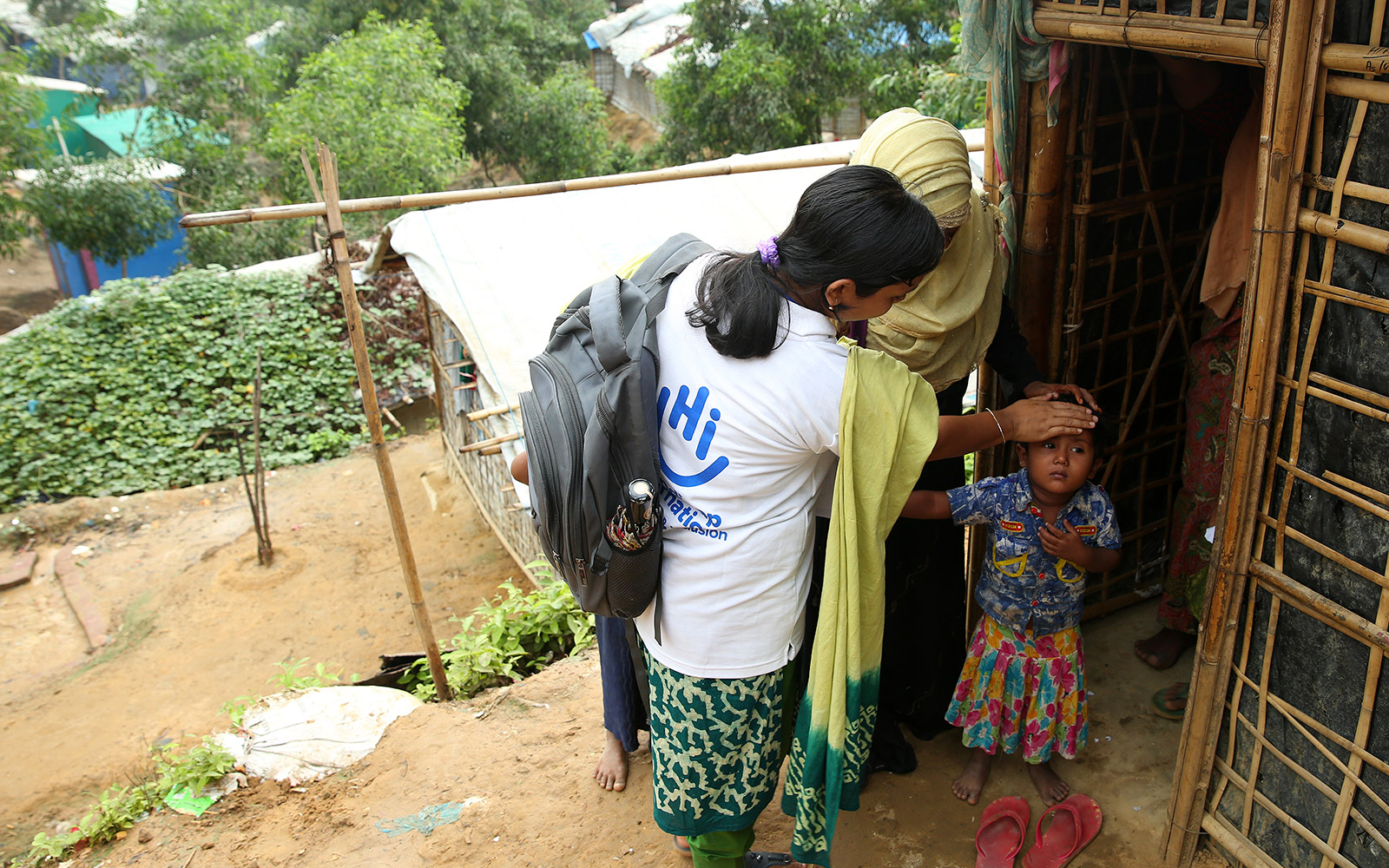From emergency response to development




Emergencies as a continuum: forward-planning, taking action, preparing for the future HI runs development and emergency response programmes in around sixty countries. When a humanitarian disaster occurs in one of these countries, our teams on site and our local partners are well-placed to launch a response. In emergency situations their in-depth understanding of the country allows them to design our emergency interventions in collaboration, where relevant, with legitimate and effective national services and partners.
We implement our emergency responses alongside our development projects as part of a contiguum. Since the World Humanitarian Summit (2016) this approach has been known as the humanitarian-development nexus. This coordination between emergency response and development work facilitates procedures for transitioning and for exiting a crisis and also helps build the population’s resilience and enhance long-term impact.
Managing and distributing humanitarian aid: Atlas Logistique
In addition to capacity-building and the training services provided to local economic actors (such as truck owners and drivers), Atlas Logistique shares its supplier network data and market analyses (catalogues, suppliers, prices, maps, identified hot spots, and security information on the roads) with the bodies in charge of emergency response in the area or country in order to facilitate the continuity of logistics activities after the withdrawal of Atlas Logistique. This simplifies the transition to the recovery and development phases.
Atlas Logistique also aims to develop logistics vulnerability monitoring capacity in key humanitarian contexts to increase our deployment capacity in crises and advise humanitarian decision- makers on strategies that focus on the hardest-to-reach communities.
HI aims to complement its direct services with community-based MHPSS approaches and with capacity-building for existing services. Progressively, and as early as possible, we help existing services providers restore or adapt capacities technically and materially through training, coaching, and material support etc.
HI’s MHPSS interventions lay the foundations for an efficient emergency response while building the transition to the recovery and development phases by:
- Providing direct services to restore the capacities of individuals, families, and communities to cope with the crisis
- Identifying and supporting existing resilience mechanisms and resources at the individual, family, community and service levels
- Identifying and supporting local services that could potentially take over from HI after the emergency
- Assessing the national government’s capacity to take over and/or develop other MHPSS services, if relevant.
- Analysing of vulnerabilities, barriers, risks, impacts, contextual environment and stakeholders
- Focusing on the most vulnerable areas and populations affected by conflict
- Reconciling local priorities with national priorities and longer-term development goals
- Defining shared objectives and priorities with other actors and authorities
In recovery phases, Humanitarian Mine Action develops local capacities, raises awareness about the threats of explosive remnants of war (ERW) and removes the most serious threats to vulnerable communities. This participatory, community-based approach provides support based on an understanding of the different aspects of community mobilisation and empowerment, from mapping leadership and management structures to community-based action planning, monitoring and evaluation.
From the recovery to the development phase, HI also implements conflict transformation activities. The goal is to support sustainable strategies to manage risks and improve human security and socio-economic development.
The first objective of humanitarian assistance programmes is to protect and improve the lives of the people in critical situations (conflicts, natural disasters, discrimination…) In principle, the first interventions of shelter programme focus on covering the most basic and immediate needs, whilst also seeking to reinforce and stabilise the foundations for development in the community in a way that will reduce or eliminate the risks linked to these vulnerable situations.
Achieving a sustainable system is a goal to be included from the outset when first defining the programme. During the first steps of an emergency the initial response must be quick and effective, and self-reliance is not necessarily an objective. However, once basic needs are met, the evolution of the response must be planned with long-term sustainability in mind.
- Appropriateness of the technology and materials employed for the context and the population;
- Quality of the design and construction of installations;
- Involvement of communities and local structures to ensure culturally-appropriate solutions;
- Capacity-building and training (management, maintenance etc.)
Physical and Functional Rehabilitation
To avoid having a negative impact on the local health system, HI's programming aims to quickly transition from direct provision of services to support for existing rehabilitation services and health authorities.
By supporting the existing rehabilitation services from the beginning, HI is able to move from full direct support (capacity-building and material and financial support allowing beneficiaries to receive services free-of-charge) to partial support focused on reinforcing rehabilitation service management and facilitating access for the most vulnerable. This may include setting up equity funds to allow rehabilitation structures to become more autonomous and transition away from HI funding and support.
From the moment we launch our activities, we work with community members to identify those affected by the crisis and at risk of complications, transmitting key prevention messages and referring people to the relevant rehabilitation and health services. This allows HI to build acceptance within the community and promote understanding of the benefits of rehabilitation. It also permits better implementation of community-based rehabilitation and the continuum of care.
Finally, HI’s work with key health actors and public authorities (such as health ministries) allows us to promote the development of health policies that incorporate essential rehabilitation services.
Livelihoods
To avoid negatively impacting the country’s development and economy, HI’s programming aims to quickly transition from direct provision of services for all people affected by the crisis to specialised services with growing involvement by national and local actors. Teams must plan for this transition from the beginning of the emergency intervention. After the initial emergency response phase, teams should focus on bolstering the local market and promoting resilience.
Livelihood activities to bolster the local market during the recovery phase
- Prioritise cash grants over kit provision as soon as the market is operational.
- Provide business start-up kits and small grants.
- Implement cash-for-work (such as for small-scale projects to rehabilitate public infrastructure and clear transport routes for supply chains).
- Provide cash distribution for the most vulnerable if cash-for-work is not accessible.
Livelihood activities to promote resilience during the development phase
- Provide training, including vocational and life-, business-, and agricultural skills training.
- Provide opportunities for coaching, mentoring, apprenticeships and internships.
- Provide business start-up kits and small grants.
- Carry out income and supply chain mapping, identify any gaps and implement activities to address them.
- Support small- and medium-sized enterprises
HI addresses barriers to humanitarian aid for the most vulnerable, and implements targeted actions to reduce the risks of discrimination, abuse and exploitation in the provision of aid.
- Provision of inclusive programmes and services
- Advocacy and awareness-raising
- Technical support for external actors on inclusive humanitarian action, the identification and reduction of specific protection-related risks, and the respect of humanitarian principles
From direct provision of a wide range of services for all people affected by the crisis, including host community members, to more specialised services with growing involvement by national and local actors partners :
- In the emergency and recovery phases, HI ensures access to inclusive service for all, including particularly vulnerable and excluded populations.
- In the development phase, HI promotes the development of inclusive policies, supports the participation and representation of people with disabilities in civil society and helps address the root causes of exclusion on the basis of disability, gender and age.
Photos : © S. Ahmed / HI - © E. Fourt / HI - © P. Sthapit / HI






